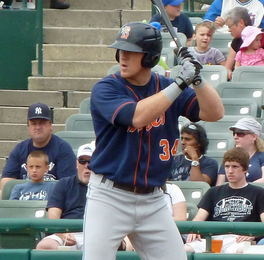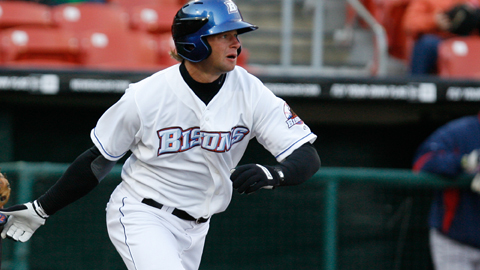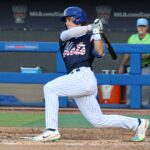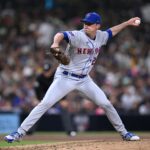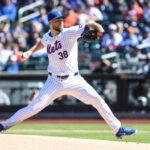Today I have the pleasure of treating you to a terrific Q & A I conducted with Wally Fish and Nathaniel Stoltz, two of the guys behind the great baseball site Seedlings To Stars.
Last week they posted their 2012 Mets Prospect List, and what makes theirs so unique is that they do theirs by listing a team’s top prospect at each position (C, 1B, 2B, 3B, SS, 3 OFs, 5 SPs and 2 RPs).
Here’s their infield, you can go to S2S for the complete list:
Catcher: Juan Centeno. Centeno is a classic short, stocky, catch-and-throw backstop with contact ability. He hit .318 in High-A at age 21 while gunning down 39% of basestealers and striking out just 22 times in 52 games, but he also drew just 12 walks and posted an .064 ISO. He could make for a good backup catcher.Grade: C+
First base: Allan Dykstra. A career .245/.388/.429 hitter, Dykstra had a solid first year in the upper minors, hitting .267/.389/.474 in Double-A. But he’ll be 25 in May, he racks up far too many strikeouts, and he’s a defensive liability. Given the standards for MLB first baseman, it would be surprising to see him experience extended MLB success. Grade: C
Second base: Reese Havens. Havens is a career .301/.379/.505 hitter in Double-A, but he’s only gotten into a total of 93 games the past two seasons due to injuries. Picked one pick ahead of Dykstra in the 2008 draft, he’s now 25 and badly needs a healthy season, but still has the potential to be an offense-oriented second baseman. Grade: B-
Third base: Wilmer Flores. Flores is the sort of guy who’s tough to judge because of his age. He’s just a career .280/.321/.394 hitter, but he’s always been very young for his levels. It feels like he’s been around forever, but he doesn’t even turn 21 until August. A longtime shortstop, he’s probably moving to third base in 2012, which is why I have him listed at the position; scouts never thought he could stay at short, and many have projected him to end up at first base. He makes contact, but the secondary skills are going to have to show up at some point, especially if he can’t stick at third. Grade: B-
Shortstop: Jordany Valdespin. Valdespin hit .294/.333/.468 between Double-A and Triple-A, but at 24, he remains raw. He has solid-average contact ability and very good power for a middle infielder, but doesn’t walk much and gets caught once in every three steal attempts. He also fielded just .925 at shortstop this past season and may have to be more of a 2B/3B in the majors. He has skills and is near the big leagues, but there’s an eerie resemblance to Ian Desmond in his skillset. Grade: B-
Here is Part One of our interview:
1. Tell us a little bit about your site. What was your inspiration and did you set any goals? What makes you different than others?
Wally: Seedlings to Stars was a twinkle in our network’s eye for quite a while, and finally became a reality last May. Back in early 2010 we were at a place where we had built all 30 MLB team sites and we were ready to launch into more general coverage. At that time I wanted to start a site dedicated to minor league baseball, prospects and the draft but before we could tackle that arena of coverage it was readily apparent that we needed to establish a presence in the general baseball market. Due to that “greater” need, Call to the Pen was launched right before Opening Day of the 2010 season. Over the next year a confluence of events occurred and the idea of launching a MiLB site fell back on the table and I jumped at the chance. I knew that I wanted to play a large role in the site’s development and direction, but also knew that with my role as FanSided’s MLB Director and my professional/family responsibilities that I wasn’t at a place where I could commit to writing 30+ quality pieces each month as I had for various sites in my time with FanSided. Being unable to produce that level of content meant I had to find a primary voice to serve as the site’s Editor. Nathaniel, who joined our network in February of 2010 had quickly become one of my closest friends and was a natural fit. I already knew from our time writing together on Call to the Pen as well as many a late night Google Chat session that we worked well together and shared a passion for the world of MiLB.
From there we set forth with a shared vision to make Seedlings to Stars a “destination” site for fans of minor league baseball, prospects, and the MLB draft while giving the FanSided.com Sports Network a presence in the MiLB world. Our initial goals were, for the most part, humble and modest. Since we launched right before the draft, we wanted to make that our first big collective project and committed to writing a relatively in depth profile on each and every first round pick. That particular goal was – in retrospect – overly ambitious. We completed it but it took 3.5 months to accomplish instead of the two weeks we thought it would take.
We’ve come a long way since then and have gone far beyond where Nathaniel and I thought we’d be at this point in our development. I’m very proud of the team of writers we’ve assembled and I think the varied voices, styles and perspectives the seven of us put into our content helps to set us apart from other sites that cover minor league baseball. As a part of the FanSided Network, we also have the luxury of having 31 other MLB sites and their respective writers available to us. This allows us to do some “in house” collaborative things like our Harvesting Opinion series as well as being able to pick the brains of team-based writers when the need arises. We also pride ourselves on being open and willing to network with other sites and believe that a cooperative environment among sites is far more beneficial to everyone than a competitive one. One of the new features of our network’s new site design allows us the ability to share links, tweets, videos and quotes from other sources on our home page through the use of “The Hub” and we plan on making full use of this new tool to pass along the minor league news and content of other sources to our readers.
I can’t speak for the direction of other sites, but we are looking forward to expanding our coverage further this year. In addition to some collaborative projects we’re planning – and our usual types of content – we’re looking to increase our draft coverage to more of a year round presence. We also plan to do a more thorough job covering day-to-day news, whether it’s large or small in scope, and track promotions, demotions and debuts in a more immediate fashion than we did last year.
2. The Mets haven’t developed a solid everyday catcher since Todd Hundley and it’s been a sore spot for most of the organization’s 50 years. Is it that catching prospects are rare and hard to find, especially offensive minded ones, or have the Mets really dropped the ball on this? It’s a little frustrating to see our best catching prospect Juan Centeno check in with a grade of C+.
Wally: The short and sweet of it is that true catching prospects are rare and hard to find. There are so many more hurdles for catchers to clear during their development time in the minors and tripping over just one (or more) of these hurdles often leads to a position change or turns into something a prospect can never fully recover from. Catchers have to be able to work with their pitching staff, have knowledge of opposing hitters and their tendencies, control the opposing team’s running game, receive the ball well, and of course provide some value with the bat. On top of all that, guys that profile to develop into truly special hitters tend to get moved out from behind the plate so they can reach the majors quicker, save the wear and tear on their bodies and maximize their offensive potential. If a catching prospect survives the minor leagues, he basically has to start all over again when he reaches the majors. Baseball history is littered with plenty of catchers who had great minor league resumes and credentials that flamed out quickly never to be heard from again. You can say this about prospects at any position but it’s especially true of those that don the “tools of ignorance.”
The Mets may have had trouble finding a quality everyday catcher but they have plenty of company in that plight. Here in Kansas City, Salvador Perez made his major league debut last season and gives the team it’s first legitimate option behind the plate since Mike Macfarlane – and it’s not like he was anything all that special outside of his 1991 and 1993 seasons. And that’s assuming Perez sticks and succeeds in the majors which we really can’t assume based on 39 games in 2011 that he hit out of his mind.
When it comes to catchers, the attrition rate of prospects is off the charts and even those who wind up ranked as their team’s top prospect are more likely to fail, or become a backup, than succeed. Adding to the difficulty of projecting catchers is that they operate on an entirely different developmental clock and timetable than the other positions.
3. I’m very surprised to see Allan Dykstra as the top first base prospect. Who was he up against and what ultimately led to your decision to go with him?
Nathaniel: He wasn’t up against a whole lot. Neither Dykstra nor any other first baseman would have ranked in my top 25 had it been a straight top-25 listing instead of by position, and no first basemen made John Sickels’ top 22 or even his honorable mentions, so I don’t seem to be alone in that opinion. It somewhat depends on who you consider a first baseman, too. Josh Satin and Zach Lutz got spot duty at the position in 2011, but I didn’t consider either as a first baseman for purposes of the list. The only competition for Dykstra is Stefan Welch, who put up some decent numbers in St. Lucie last year. After all, Triple-A’s slot was mostly taken up by Val Pascucci, and the Savannah affiliate had a pair of ineffective older hitters at the position, so it really just comes down to Dykstra and Welch.
That said, it’s really not something to lose sleep over. I just wrote an article called “There Is No Such Thing As a First Base Prospect,” that points out that in any given minor league class, there are probably less than five minor league first basemen that go on to be above-average major league players, because about half of major league first basemen convert to the position from elsewhere. Therefore, there really aren’t more than 8-10 good first base prospects in the minors at any given time. The Mets already have Lucas Duda and Ike Davis, so it’s understandably not a priority for them to stock up at that position. In that context, Dykstra—who did put up an .864 OPS in Double-A last year, not something to scoff at—is totally fine to have as the top 1B prospect.
4. Which Mets prospects, regardless of your rankings, should we expect to see in 2012? Can you give us 3-4 names and also tell us whether these players will be longterm fixtures in Flushing?
Nathaniel: You saw a glimpse of Josh Satin last September, and at age 27, he’ll probably finally get his shot. He’s not more than a complementary guy—the guy I compare him to is Ty Wigginton, as he’s an unathletic guy who can just get by at second and can hit just enough to play at the corners occasionally. He has a strikeout problem that will likely prevent him from being even as good as Wigginton, but he’s a nice fit as a versatile offense-oriented utility player.
Kirk Nieuwenhuis had over a .400 OBP in Triple-A last year, so he’s pretty much ready as well. Like Satin, his upside is limited by strikeouts, but there’s a lot to like here. Niewenhuis will rip a lot of doubles and the occasional homer, he gets on base, and he can handle all three outfield spots. He probably shouldn’t play against his fellow lefties, but he could have a long career as a Seth Smith-style righty-masher.
Matt Harvey and Jeurys Familia, two of the team’s vaunted trio of pitching prospects, should open 2012 in Triple-A Buffalo, and if they excel and a need arises in the majors, they could be up late in the year. Both have the potential to be important parts of the Mets rotation for the rest of the decade. Chris Schwinden and Collin McHugh could get some starts in 2012 if the team elects to let Harvey and Familia ripen more. Schwinden, of course, got a few starts for the Mets last September and didn’t embarrass himself. McHugh had a fantastic year in Double-A and is a very polished pitcher who might surprise some people.
I’ll post Part Two of our interview with Seedlings To Stars later today, along with some final thoughts by me. In the meantime, if you haven’t already, make sure to add them to your favorites and to your e-readers.

